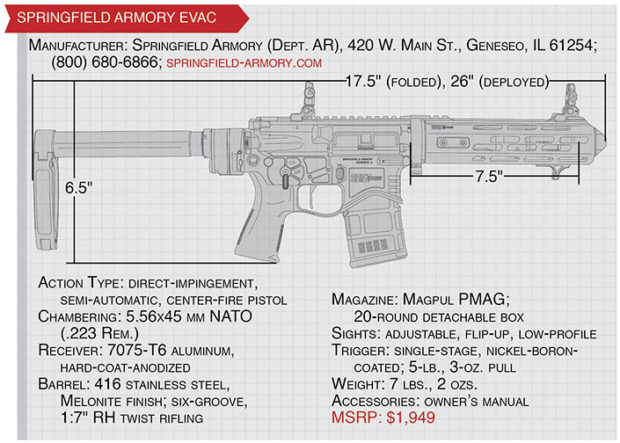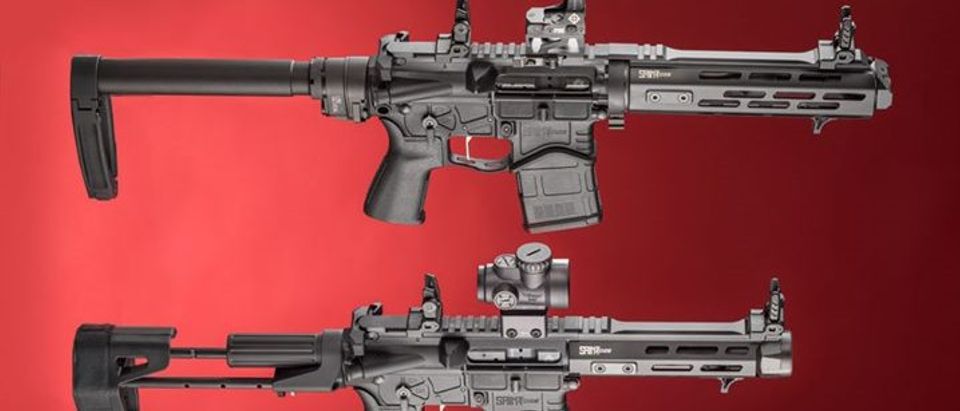By Kelly Young, American Rifleman
I sense a pattern beginning to emerge. It’s almost as if owner and CEO Dennis Reese walked into a Springfield Armory product strategy meeting at some point in 2018 and decreed, “I want you to make everything smaller!”—because much of the company’s design focus since right about that time has been on compactification.
Heck, even the M1A’s most recent new model is the relatively abridged 16″-barreled Tanker. Fresh off the introduction of the Hellcat (the manufacturer’s superb contribution to the budding yet immediately booming micro-compact pistol market), Springfield is pushing the bounds of conventional size constraints yet again in 2020 with the announcement of a trio of exceptionally small and agile additions to its Saint family of AR-platform firearms: the Edge PDW, Edge EVAC and Victor .308 pistols. And as an outspoken proponent of explicitly short and light firearms—for both entirely practical and wholly recreational reasons—I’m loving every second of it.
Particularly interested in the two .223 Rem.-chambered Edge pistols, Rifleman reached out to Springfield immediately following their unveiling at SHOT Show 2020 to request a test sample of each. Generally speaking, the AR platform has continued to shrink in size since basically the original conception of the AR-10, and that trend has accelerated sharply during the past five years or so.
Today, most AR makers offer at least one large-format pistol option and many have entire pistol lines, and at a time when the AR market as a whole is struggling, consumers continue to snatch these pint-size models up in large quantities. Most of the manufacturers that I’ve spoken to confirm that their AR-pistol variants have become among the fastest-moving product segments in their catalogs during recent years—and in some cases it’s by a rather wide margin.
Springfield Armory was quick to respond to the current trend, striking while the iron was hot by introducing its first Saint pistol back in 2017. But neither the PDW nor the EVAC are your run-of-the-mill AR pistol; they take the movement into exciting new directions by offering functionality beyond just a shortened form factor. Similar in core operation and sharing nearly identical receiver sets, the two models both offer extreme portability, they just come at the concept from two divergent approaches, differentiating themselves primarily by way of their highly specialized furniture.
The PDW enters the rifle-caliber AR-pistol scene as one of its most diminutive members, a result of its 5.5″ barrel being paired with a quick-deploy Maxim Defense SCW Brace that can be collapsed all the way down to the very end of its proprietary truncated receiver extension. Measuring just 18.75″ while stowed but only 23.50″ with its arm brace fully extended, the seriously compact PDW weighs a mere 5 lbs., 11 ozs.
On the other hand, the 7.5″-barreled takedown EVAC was designed for discreet storage within, and rapid assembly from, its included 12″x10″x5″ padded carrying case thanks to a folding arm brace assembly and patent-pending removable handguard/barrel system. The former is Law Tactical’s Gen 3-M Folding Stock Adapter; the latter is Pantheon Arms’ Dolos Take-down System.
These are both intended to be serious defensive tools, and, as such, my initial interest in evaluating them was essentially threefold. First, although Springfield has seemingly chosen its partners well, and the OEM components used by these pistols are well-regarded within the industry, they are still systems that are more complicated and less battle-proven than the simple tried-and-true designs of conventional ARs, so reliability was my utmost concern. An especially small “paperweight” is less valuable in a fight than a larger gun that actually runs.
Second, sure, rifle-caliber AR pistols are incredibly popular right now, but do they actually generate enough kinetic energy to be viable fight stoppers? It varies by propellant, but .223 Rem. typically requires at least 24″ of barrel length in order to achieve full burn. So pistol-length barrels leave a significant amount of ballistic potential on the table—and the velocity loss per inch often increases greatly as barrel length decreases.
Sure, a shorter-barreled package is handy, but I wanted to determine firsthand whether the compact barrels of the new Saint Edge pistols were sacrificing too much effectiveness for the sake of maneuverability. Also, something to be aware of: Ammunition is designed to function within a specific envelope of velocities, and the abbreviated barrel of an AR pistol may very well drop your load of choice below this terminal performance window—although soft-point projectiles do tend to be more forgiving in this regard, typically expanding at a wider range of velocities.
Third, short-barreled .223 Remingtons throw a lot of sound and fury by virtue of their unburnt powder (see above), making proper flash/blast mitigation a vital consideration for those planning to rely on these guns in defense of life and limb, potentially while in the dark. Otherwise you run the risk of basically flashbanging yourself into a stupor after just a few shots—during a circumstance where you’d best have your wits and senses at your disposal. So I was curious to gauge just how well the muzzle devices selected for the PDW and EVAC handled the maelstroms their guns were creating.
How’d the new Saint Edge pistols fare? I’ll cover that in a bit, but as I alluded to above, the PDW and EVAC share a lot of common DNA, so before getting to the aspects of each gun that distinguishes it from the other (and from plain-Jane AR pistols), I’ll first briefly touch on what the two new models have in common.
Shared Components
Both new Saint Edge pistols are built around forged 7075-T6 aluminum upper and lower receivers that are then hard-coat-anodized for added durability. Lightening cuts have been made to portions of the receivers that aren’t high-stress areas in an effort to minimize nonessential mass.
The upper of each pistol makes use of a right-side forward-assist plunger, brass deflector and dustcover, and the lower employs M4-style feed ramps and incorporates an integrally machined trigger guard as well as a flared and deeply relieved magazine well. Springfield’s nylon-tipped Accu-Tite tensioning screw is also present, making it possible to remove any play from between the two receivers.
A 5″ section of Picatinny rail runs atop the upper receiver of both the PDW and the EVAC for the installation of an optic, and both come with a supplemental set of irons sights—in my opinion an absolute necessity for a defensive gun that might be called into action at any time. The sights included with the Saint Edge pistols are a polymer, adjustable, flip-up set with a post front and a dual-aperture rear.
Each pistol employs a direct-impingement operating system, with a low-profile gas block pinned to the barrel 4.5″ from the chamber on the PDW and at 5″ in the case of the EVAC. Given their extremely short-barreled nature, both pistols also come from Springfield with a forward hand stop affixed to their handguards at the 6-o’clock position, and even with this safeguard in place, you’re going to want to be extra mindful of the placement of your fingers as you run these guns—as wandering too far forward is a mistake you only get to make once.

–
The PDW and EVAC each make use of Reptilia’s CQG pistol grip, a lightweight polymer unit designed with a more vertical grip angle specifically for use with large-format pistols and short-barreled rifles. Shortened slightly to both cut weight and to streamline its profile, the CQG stands just shy of 3.5″ tall, compared to standard pistol grips that are typically closer to 4″ in length. Each pistol ships with one 20-round Magpul PMAG, and while the guns are naturally capable of accepting and feeding from standard-capacity 30-round boxes, the shorter magazine’s baseplate aligns nearly perfectly with the toe of Reptilia’s grip, which should help limit snagging.
As members of the performance-driven Edge subfamily of Saint firearms, Springfield’s most highly refined AR models, both the PDW and EVAC benefit from a number of bells and whistles that provide enhanced performance. Chief among these, to my mind, is an excellent nickel-boron-coated, micro-polished, single-stage trigger.
The flat-blade triggers on both our sample pistols were better than average, with no perceivable take-up or overtravel, and only slight creep before the relatively light break. Taking the average of 10 pulls, the PDW slightly bested the EVAC, its trigger breaking at 4 lbs., 12 ozs., compared to 5 lbs., 3 ozs., for the larger takedown. Both were far better than is typically necessary for a short-range defensive encounter, but there’s no such thing as excessive performance when your life is on the line.
Saint Edge guns do provide a bit of extra functionality for southpaw shooters that the baseline and Victor models do not, in the form of bilateral 90-degree safeties, however, the mid-size charging handle that comes with either the PDW or the EVAC features only a left-side latch for right-handed use. All other controls are in the standard locations for the AR platform: The push-button magazine release is on the right side of the lower receiver above the magazine well, and the bolt release lever is opposite it on the left side.
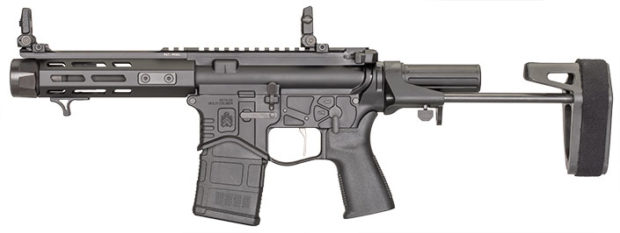
Saint Edge PDW
The Saint Edge PDW is not the first AR pistol to utilize a CQB-style sliding arm brace such as the Maxim SCW to achieve extraordinary compactness. However, Springfield is certainly the largest manufacturer to date to apply this concept to the AR platform, meaning that not only will the PDW almost certainly be the most readily available gun of this type, but—at an MSRP of $1,699—it will likely be the least expensive option as well.
Maxim’s SCW assembly is composed of several parts. A 7075 aluminum housing is attached directly to the rear of the lower receiver, with an abbreviated (about 4″ long) receiver extension threaded to the receiver through a hole in the housing. A rubber forearm loop connects to the housing via a pair of rigid steel rods, and when the brace is collapsed, these rods extend through the housing to ride along either side of the lower. Internally, the system utilizes a proprietary buffer/bolt carrier system in which the forward end of the buffer nests within the tail of a shortened bolt carrier design.
The SCW can be deployed to any of five length settings (each about 13⁄16″ apart) thanks to a series of notches cut into the rods that engage a detent in the housing. In its retracted state, the unit’s rods do make it somewhat more difficult to actuate the pistol’s safety selectors, and there is just barely enough room for the charging handle to make its full travel to the rear, but all operations are possible nonetheless, and the PDW is capable of both firing and cycling regardless of the configuration of the brace. An ambidextrous QD sling socket in the rear, bottom of the housing is conveniently placed for use with a single-point sling.
To extend the brace, simply pull back on the forearm loop until the detent engages the length-setting notch of your choice. Once locked in place, depressing a button on the left side of the housing allows the SCW to be shortened again. Many AR pistols offer no length adjustability at all, while others permit a small amount, but they basically require you to take the gun out of commission in order to make a change—that the PDW can be deployed to full readiness in a split second, without the need to find and activate a control, presents a major tactical advantage.
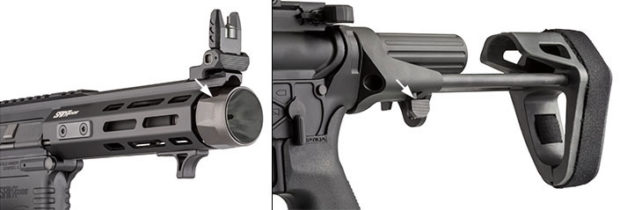
–
Given the exotic nature of its rear end, the PDW’s handguard and barrel seem relatively mundane by comparison. The pistol’s 5.5″ chrome-moly-vanadium steel barrel is cut with six-groove, 1:7″ right-hand-twist rifling, and it has been given a Melonite finish both inside and out to enhance corrosion and wear resistance.
Affixed to the barrel via 1/2×28 TPI threads, the Maxim Hate Brake is a combination muzzle booster/linear compensator that regulates exhaust gases to enhance reliability while simultaneously directing flash and blast forward and away from the shooter. It’s a bit tight in a few places, but the PDW’s aluminum handguard is free-floated of the barrel. The octagonal fore-end bears at least one M-Lok-compatible slot on seven of its eight faces, with the top surface instead featuring a pair of Picatinny rail slots at each end.
During function testing, the PDW worked great; I ran the pistol hard—to the point of heating up the handguard to sweltering levels—but reliability stayed constant throughout. The shape of the SCW brace may make establishing and keeping cheekweld problematic for some shooters, depending on how far forward they like to choke up on the gun.
Shooters who typically square-up on their target will likely have no problem maintaining contact with a forward-extending lip on the forearm loop, and people who tend to crowd the charging handle will likewise find plenty of real estate on the receiver extension for their face. However, those who generally hold their cheek to the gun somewhere in the middle distance may not have a particularly comfortable shooting experience.
As far as accuracy is concerned, the PDW is more than up to the task of a short-range defensive encounter. Firing five, five-shot groups, my three test loads—Hornady’s 73-gr. Critical Defense Rifle, Remington’s 62-gr. Ultimate Defense Rifle Bonded and Speer’s 75-gr. Gold Dot—managed an average extreme spread of 2.12″ at 50 yds., a result that would have been even more impressive had the gun not shown a strong distaste for the selected Remington ammunition. Chronograph results show that the pistol was generating about 425 ft.-lbs. of energy at 15 ft., which is less than half of what could be expected from a 16″ carbine, but, with good shot placement and properly expanding ammunition, this would be sufficient to stop a threat.

I have to give Maxim’s Hate Brake high marks in the blast/flash abatement department, as, while the pistol is unquestionably loud, I shot the two Saint Edge pistols side-by-side, and despite its shorter 5.5″ barrel, the PDW did seem to be the quieter of the two. And while fireballs were frequently observed, particularly once the range lights were turned down, the flash wasn’t as bad as initially feared. Felt recoil, while certainly more than a conventional .223 Rem. carbine, was highly manageable.
Springfield Armory dared to dream small—superlatively small—with its new Saint Edge PDW, and what it does, it does well. The package is considerably more controllable than a handgun, while being far more handy and maneuverable than a 16″ carbine. It will just be up to the buying market to decide whether the PDW’s advantages overshadow the compromises inherent to all .223 Rem.-chambered AR pistols.

_____________________________________________________________________
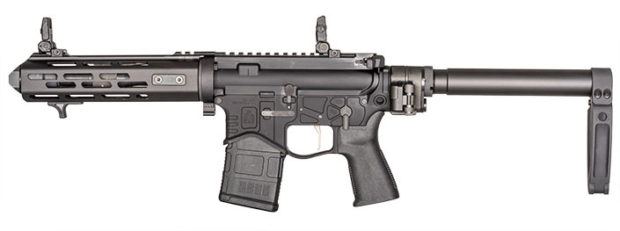
Saint Edge EVAC
As with the PDW, the components that lend the EVAC its distinctive portability aren’t exactly new, but their inclusion on a Springfield Saint will bring them much more fully into the mainstream spotlight. Conceptually, I love the idea of this pistol; inconspicuous and convenient to transport, yet relatively swift to assemble and bring to bear on a threat, the EVAC has enormous potential as either a truck gun or a go-bag essential, and it offers an impressive amount of firepower in either role. But my previous experience with both folding and takedown ARs has been spotty at best, so going into this evaluation I was more than a little leery of a design that employs both. I’m happy to report that the subsequent performance of the gun has put my early concerns to rest.

The typical direct-impingement AR’s reliance on a buffer mechanism that reciprocates within its tubular receiver extension during operation precludes the use of a folding stock/brace design. The Law Tactical Gen 3-M works around this limitation because, not only does the 4140 steel adapter introduce a left-folding hinge at the rear of the lower receiver, but it also includes an extension that installs to the rear of the gun’s bolt carrier to ensure proper function of the buffer when the unit is not folded. The EVAC is capable of firing in its folded position, but this practice is not endorsed by Springfield, and it obviously cannot cycle while in this condition.
Protruding from the rear of the Law Tactical adaptor is a receiver extension designed specifically for use with the included Gear Head Works Tailhook Mod 1 pistol brace. Quick-detach sling sockets abound on the EVAC, as one is cut into each side of the lower receiver just behind the rear takedown pin, the Gen 3-M has one each on its rear and bottom faces, and another is present on the left side of the Tailhook Mod 1. With no provision for length adjustment, the 7.5″-barreled EVAC measures 17.5″ when folded and 26″ when deployed.
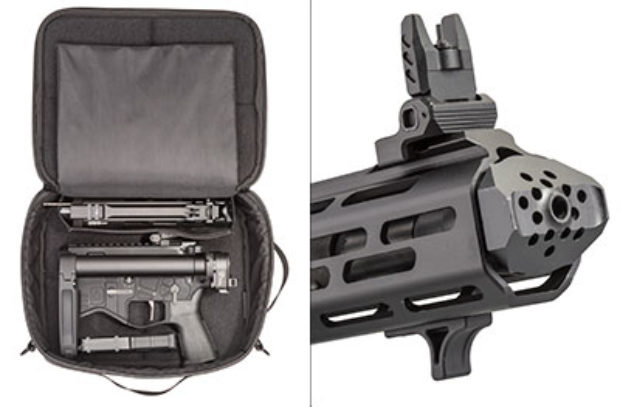
Pantheon Arms’ Dolos takedown system consists of an aluminum tri-lug assembly affixed to the upper receiver that interfaces with a steel lock collar connected to the handguard/barrel assembly via a ratcheting mechanism. It’s a really simple design to operate.
To assemble from its stowed state: lock the bolt carrier group (BCG) back; insert the gas tube and chamber into their corresponding holes in the upper receiver; and then twist the fore-end in the counterclockwise direction until hand-tight and the Picatinny rail atop the handguard aligns with the rail atop the receiver.
To disassemble, simply lock the BCG back and pull down on the unlocking tab at the bottom of the tri-lug assembly while rotating the handguard clockwise until the fore-end and barrel come free. Damage to the system is possible if the BCG is allowed to slam home under spring tension while the handguard is detached, so care should be taken to ease the action closed when the two components are separated.
Apart from its takedown capabilities, the EVAC’s free-floating handguard is a fairly standard M-Lok-compatible aluminum unit. Given the gun’s potential in an outdoor survivalist scenario, Springfield decided to make the pistol’s barrel out of 416 stainless steel in order to provide an added layer of rust resistance beyond its Melonite finish.
The barrel is rifled at the same twist rate as the PDW, and the muzzle is also threaded 1/2×28 TPI, but instead of the Maxim Hate Brake, the EVAC comes from the factory with a new proprietary brake that disperses gases through 14 holes arranged around the muzzle in the shape of a seven-pointed star.
In all, the gun weighs 7 lbs., 2 ozs., which is a bit heavier than might be expected of a compact AR pistol, but given the added metal employed by both the arm brace and handguard assemblies, this shouldn’t be too surprising. Use of the Law Tactical and Pantheon Arms designs together does require that a proper sequence be followed in order to efficiently deploy the EVAC, however, as the Gen 3-M cannot be folded with the BCG to the rear, but the Dolos system requires that it be locked back in order for the handguard/barrel to be attached/detached.

For fast deployment, first unfold the receiver extension and lock the Gen 3-M in the open position. Next, use the charging handle and bolt release lever to lock the BCG back. Lastly, affix the handguard assembly and release the bolt forward to chamber a round. With just a small amount of practice I was able to get the entire operation—from concealed within its Blackhawk-brand case to fully ready to rock—down to just more than 10 seconds.
The EVAC’s rectangular storage case is compact enough to fit within most medium-size backpacks and many desk drawers, on most bookshelves, and even under some car seats. And, of course, the bag is nondescript enough to hide in plain sight in those situations where gun security is not a concern. I do, however, have one nit to pick; in its stowed configuration within the storage case, the tip of the EVAC’s gas tube is somewhat unprotected and vulnerable to damage if the padded box is impacted hard enough on that side. It’s unlikely to be an issue for most users, but the potential for mishap is there.
Function testing of the gun went smoothly; there was one failure to extract that occurred very early on, but the EVAC quickly sorted itself out and ran without any further hiccups. At around the 300-round mark I did notice the easy operation of the Dolos mechanism start to become increasingly gritty, a problem that was immediately remedied by a thorough cleaning and greasing.
Shooters planning to both put a lot of rounds through their EVACs and to de-assemble/re-assemble it frequently would be wise to give that interface some extra attention during maintenance. The EVAC was noticeably louder than the PDW, and it seemed to produce more flash as well. This is mitigated somewhat by the fact that its probable intended uses are less likely to be indoors within an enclosed space than the PDW’s are.
Using the same three loads I shot through the PDW, the EVAC performed slightly better accuracy-wise than its smaller brother, and the extra 2″ of barrel did cause pretty significant increases (between 31 and 53 percent) in the velocities those ammunitions produced.
I also shot one 15-round group at 25 yds.—removing and then re-installing the handguard/barrel assembly after every three rounds—to determine whether any point-of-impact shift was occurring. The result was a tight 13-round cluster with only two impacts that could even very liberally be considered fliers, so I’d say if any shift is occurring, it’s not by a particularly meaningful amount for a fighting gun at fighting distances.
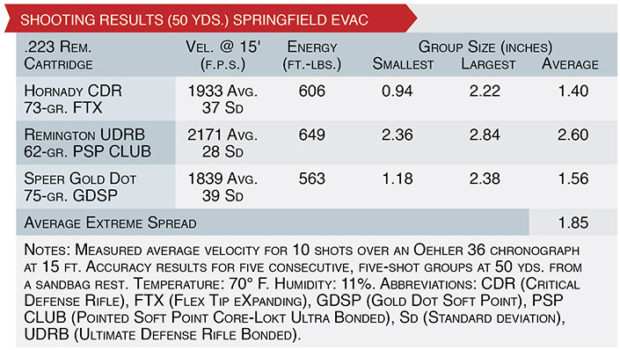
–
At an MSRP of $1,949, the EVAC is Springfield’s most expensive Saint, but it also offers capabilities that no other model in the line—and very few ARs across the entire industry, for that matter—can. The ease with which it can be inconspicuously transported and stored allows it to provide a level of preparedness, in new places and new ways, previously unavailable to the AR platform. Like I said before, folding and/or takedown ARs have been pretty hit-or-miss up to this point, and it’s nice to see how this type of gun looks when a company knocks the concept out of the park.
